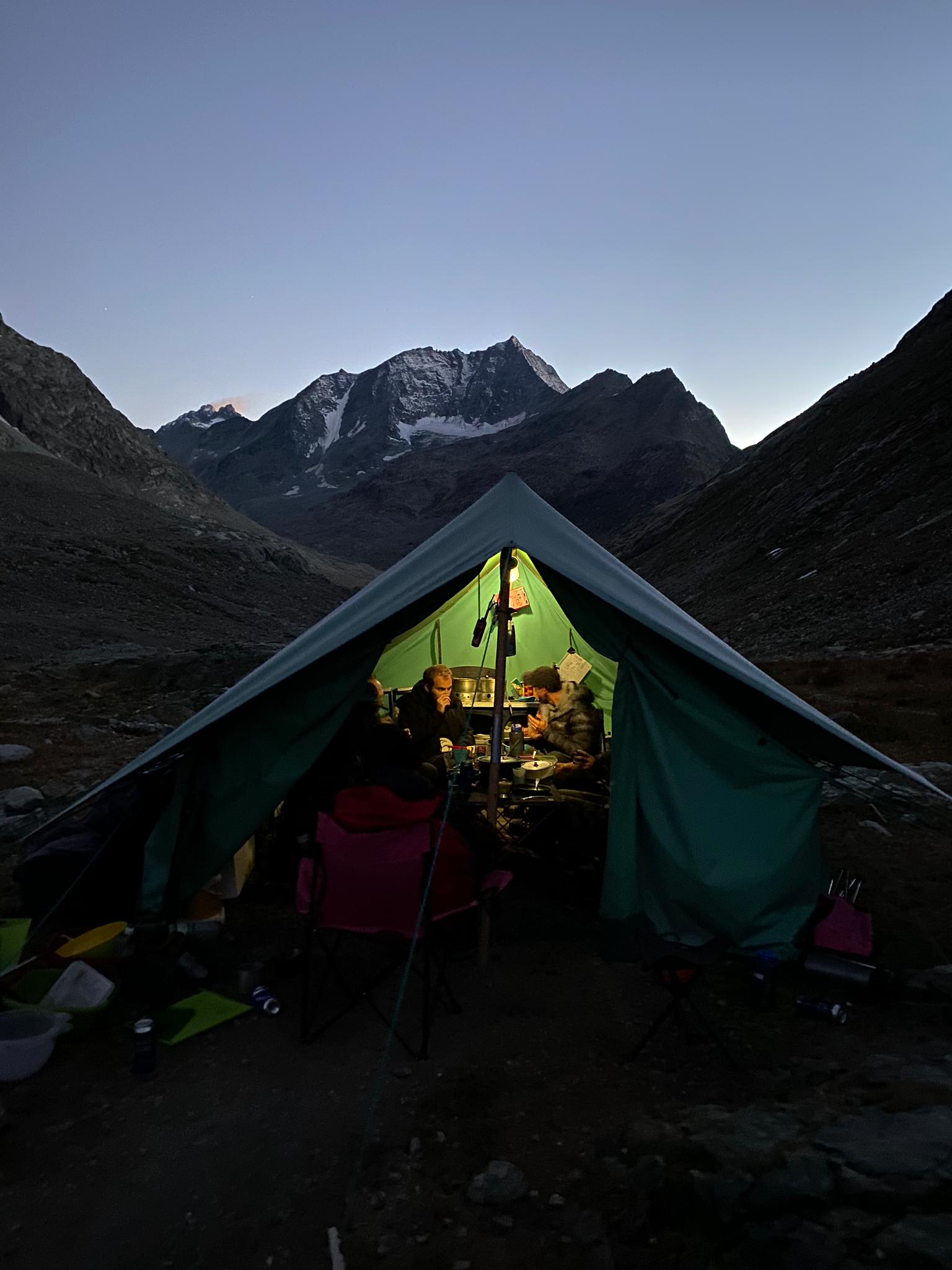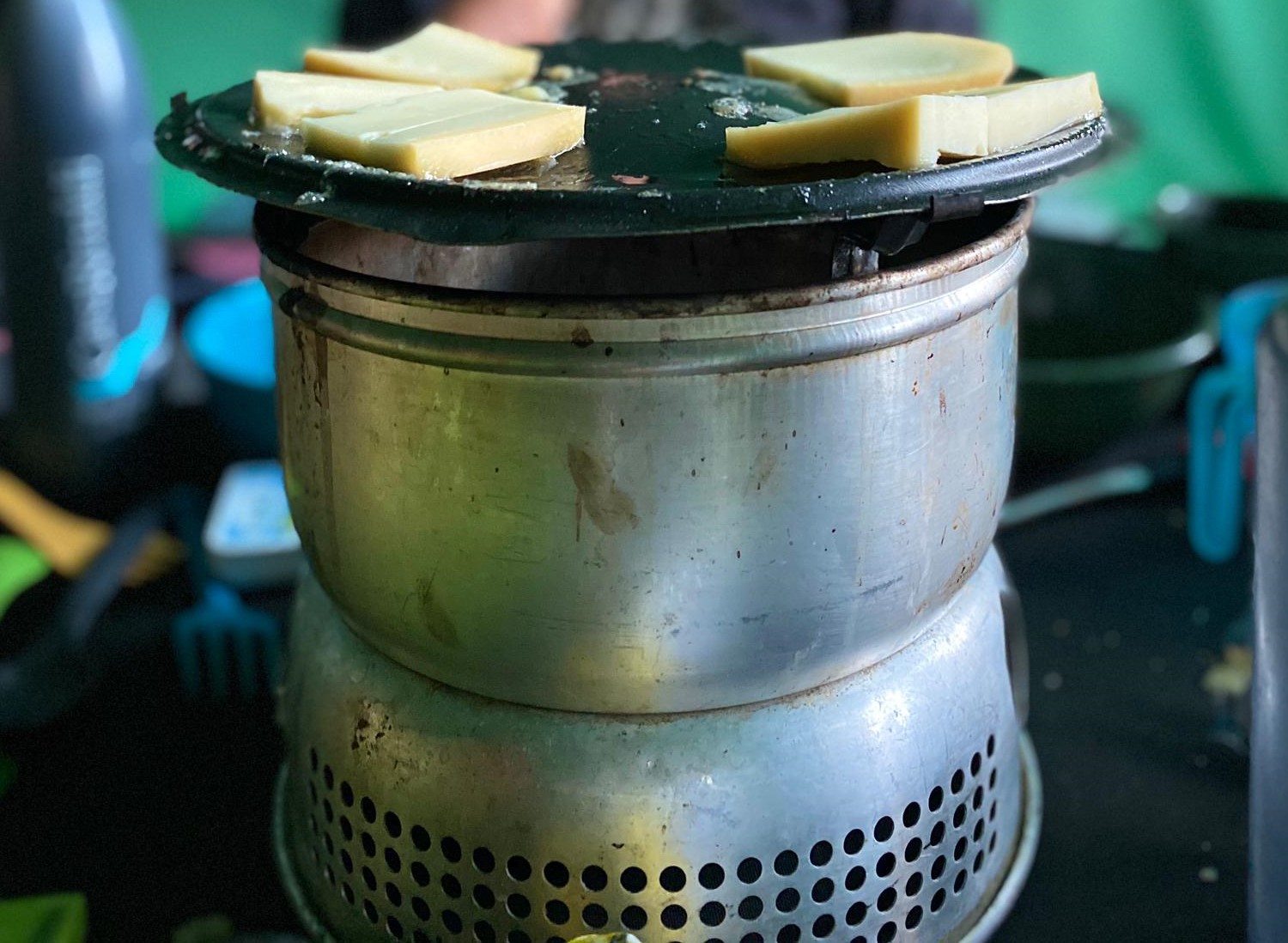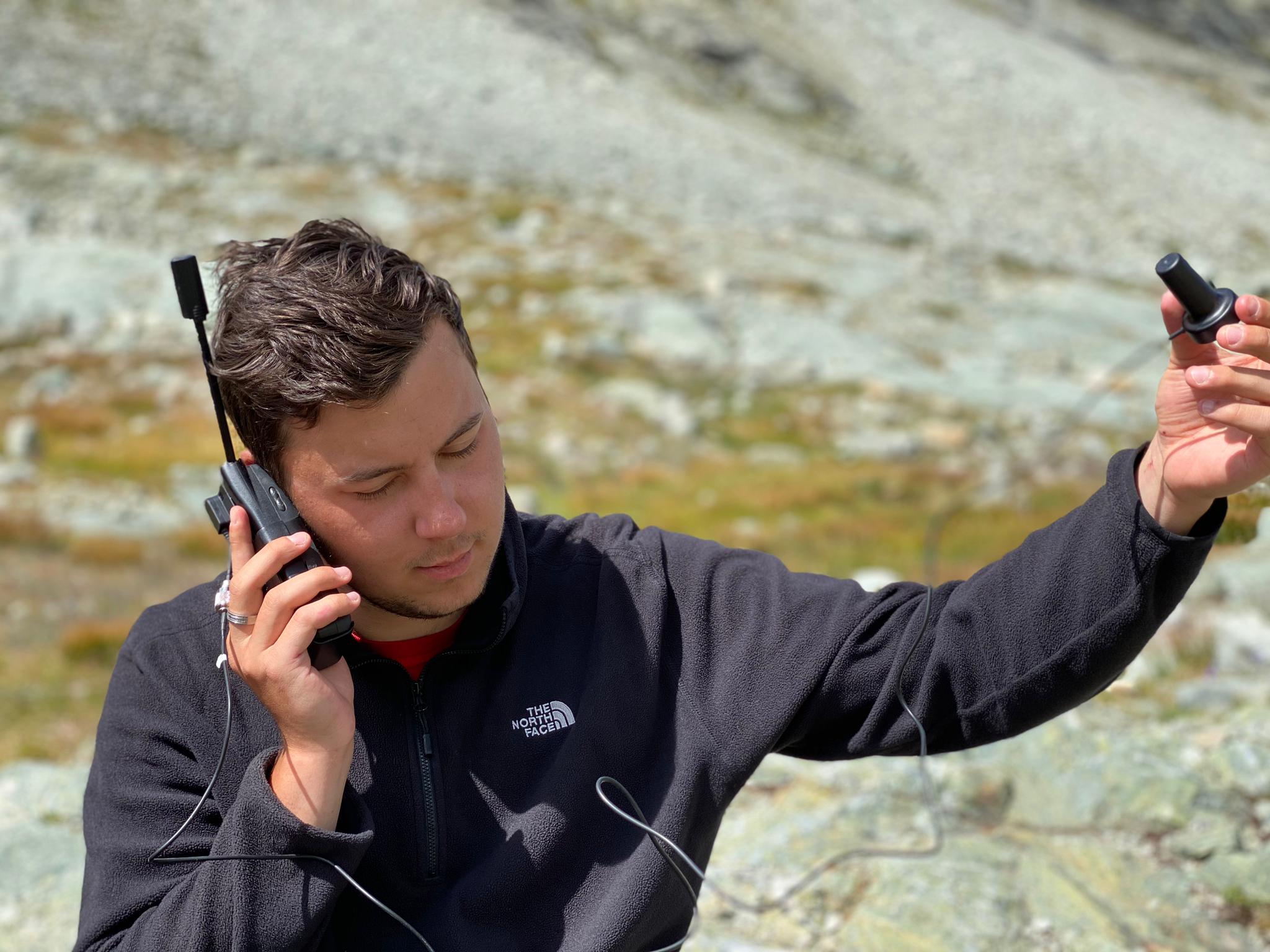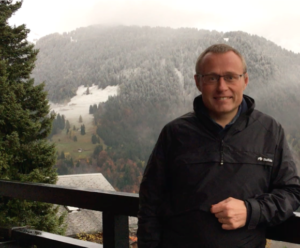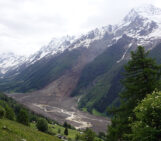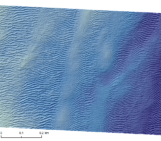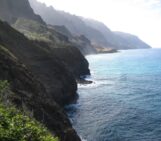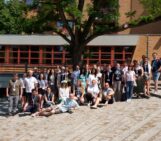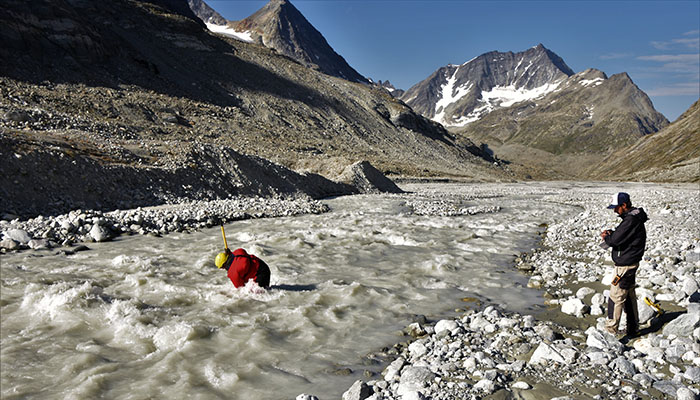
This is a joint post, published together with the hydrological sciences division blog, the cryospheric sciences division blog, the geomorphology division blog, given the interdisciplinarity of the topic.
– Floreana Miesen and Prof. Dr. Stuart Lane, University of Lausanne –
In Switzerland, nothing is really remote, but some places are more so than others. Dense infrastructure networks typically provide convenient access to research sites in the Alps where it is difficult to feel far away from home. However, this is not always the case…
For us, our home for the summer is a bit different. We work at 2400 m above sea level in Southern Switzerland, in a narrow valley running parallel to the Swiss-Italian border. Our base camp is pitched right at the edge of the floodplain of the Otemma glacier, Switzerland’s third longest glacier. The area is not known to many, because there are no ski slopes, no expensive hotels, not even a mountain hut, let alone a road to make normal-level adventurers consider a trip up the valley. Whilst Tuesdays is normally the day that a small group of guided tourists passes by as part of the tour of the Grand Combin, our most frequent visitors are the overflying jets of the Swiss army, and more rarely a helicopter high in the sky. The sonic boom of the overflying jets is the only thing that disturbs the peace of the area, as with no telephone network, no mobile phone conversations are possible either. In Swiss terms, this is just about as remote as it gets.
Despite being remote, Otemma glacier provides a stunning natural laboratory for understanding how the signal of rapid climate warming is propagating through an Alpine environment that includes ice, sediments, water and biological ecosystems. All too often, these domains are considered separately. At Otemma glacier though, things are connected. It is the main study site of four PhD projects funded by the Swiss National Science Foundation, each project connecting being connected to at least another one, and supported by Master’s and Bachelor’s projects. The camp provides a field base during the entire summer, from June to September. Fieldwork stretches from the lower half of the glacier across the floodplain all the way down to a hydropower plant. The fieldwork involves surveying the glacier and its hydrology (on top of the ice, within the ice and below the ice); studying the sediment dynamics under the glacier and in over the plain in front of it; observing biofilms which can grow almost anywhere (even when starved of light) and vegetation succession.
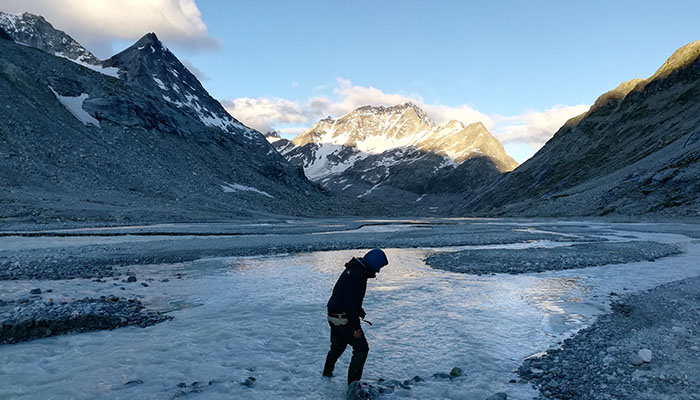
Stomping around to calibrate the seismic station in the early morning hours when the water level is low. Photo: Matthew Jenkin
Over the summer, the field site gets spiked with instrumentation aiming to provide a picture that is as complete as possible of the natural processes taking place. Glacier ablation stakes, drone flights, differential GPS surveys, environmental seismometers, radio-tagged particles, gauging stations, dye tracing, sediment and biofilm sampling and the list goes on. Truly an interdisciplinary playground, having so many dedicated people with different research foci at this field site allows exciting discussions and in-field learning from each other.
Being off the grid at a site that is not easily accessible independently provides a challenge to logistics and organising people’s presence at the camp. Careful preparations, planning and occasional satellite phone texting are essential to keep things running smoothly. The daily routine at the camp is very much directed by nature’s diktat, by the position of the sun and the amount of daylight, the strength of wind and the visibility for drone imagery, but most importantly, the water level of the glacier-fed stream, one of the main drivers in the grand ensemble of natural processes we study. Only in the early morning hours dare we enter the water, to sample the impressive amount of sediment travelling downstream, or to stamp on the ground in a choreographed way so as to calibrate the passive seismic stations installed close to the stream.

Full immersion into the glacier-fed stream – even your body understands what’s meant by “high discharge”. Photo: Valentine Grunwald
The advantage of running a permanent camp throughout the entire season is that we can experience hydrologic (related to water), cryospheric (related to ice) and geomorphic (related to the earth surface) processes “live”. Experience is not just about seeing – it is also about hearing the stream’s roar, smelling the early summer flowers, feeling the cold when you have to be out before daylight, ready to get those early drone surveys done. Perhaps most striking is the passing of the season: the up-glacier retreat of the snow line, the downward lowering of the glacier due to melt, the draining of groundwater in the outwash plain, the rock falls that become more frequent as the summer warms up, the flourishing of the biofilms, the greening of the vegetation and its later die back as the summer ends. We feel the mosquitoes joining the camp somewhere midway into the summer. With the insects, birds start to circle more frequently over the camp too, joining our daily drone missions in the sky. We feel the pebbles roll over our feet as we wade the river.
At night, we fall asleep to the sound of the bedload (the rocks and pebbles carried along the bed of the river) rumbling in the river and it is not unheard of to dream of endless grain size counts. As opposed to other contemporary field research campaigns with automated sampling, and occasional field visits for calibration, we cannot leave things running by themselves and come back when we think the data is enough. The environment is too capricious for us to leave it in charge. Our time scale is one that is vivid – we look at diurnal and seasonal dynamics, how the floodplain changes face not only over the summer but even over the course of the day. During thunderstorms, we seek shelter in our scout tents, huddle to escape the hail and heavy rain and once it is safe, we run out excitedly to watch the effects of the storm on the river stage and sediment transportation directly before our eyes. The high frequency of our sampling (including for calibrating our automated data) prompts us to be there. It is like watching a live stream of proglacial processes. In a way, this type of fieldwork really connects the researchers with their data.
As the turbulent glacier-fed stream gets quieter towards the end of summer, so does the camp. With the routines well established, only one or two people are needed to keep things running at times. At the peak of this summer however, the camp accommodated 8 to 10 people, momentarily (for two nights) rising to more than 20 when a bubbly group of Master’s students from Bern took the chance to visit the research site for a few days.
Short visits are certainly welcome and a lovely change to the scene. Introducing visitors to the running research campaign is a good way to reflect upon the project and to put things into perspective. Sometimes this perspective may be blurred, however, such as when our Faculty Dean happened to pay us a surprise visit, just as the entire camp and floodplain were drowned in a dense mist. All that was left to say while pointing into the grey wisps of fog was that, “in theory, you would see a spectacular, breathtakingly beautiful landscape…”. Other days, while people in the lowlands are enjoying a refreshing summer bath in Lake Geneva, snowfall changes the otherwise colourful appearance of our camp. Every hour throughout the night, we then have to take turns to shake off the snow from the tents to prevent them from collapsing under the weight of the snow. Thankfully, most days, the overall dry conditions in this area of the Alps provide us with enough solar radiation to feed our batteries and keep our equipment running.
The great appetite for studying the landscape at Otemma glacier goes along with rumbling tummies at the end of long days out in the field. Almost a ton of food supplies is brought up to camp at the beginning of the summer, and cooking becomes a bonding activity in the evenings. There is never lack of Swiss cheese, without doubt. On Swiss national day, cheese fondue on the camping stove is a must, much to the delight of the ones whose turn it is to do the dishes that evening – scratching off the remains of the finest Swiss cheese from a camping pot in a freezing glacier stream… Occasionally, motivation declines when there is no more chocolate left.
These kinds of field camps are nothing new, and the logistics of running such camps pale when compared to what is needed in high latitude environments such as the Antarctic. But to be so isolated in a European setting is nowadays, with widespread mobile phone networks, much rarer. Perhaps the most endearing memory of life in camp was a young Bachelor’s student who, during their two weeks at Otemma glacier camp, could not quite get out of the habit of checking their smartphone, a few times an hour, in the hope of perhaps finally accessing the never-to-be-accessible mobile phone network.
Author information
Floreana Miesen is a field technician and junior researcher at the Institute of Earth Surface Dynamics, University of Lausanne . floreana.miesen@unil.ch, @thestatusflo
Stuart Lane is Professor of Geomorphology, head of the group AlpWISE, at the Institute of Earth Surface Dynamics, University of Lausanne. stuart.lane@unil.ch. @alp_wise


